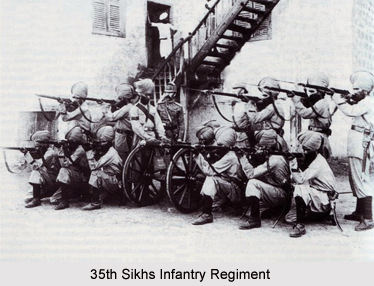 The 35th Sikhs regiment was an infantry battalion of the British East India Company. The unit was raised in the year 1887 and existed till 1922. It was a part of the Bengal Army, which was the official armed force of the Bengal Presidency and was one of the Presidency Armies in British India. The formal administration of the British Presidency Armies in India was controlled by a chain of command. The infantry regiments of the army of Bengal province went through many modifications of numbering. The Bengal Army infantry regiments operated under the administrative authority of British East India Company. Subsequently the British Empire in India took over the 3 British Presidency Armies that is the Madras Army, the Bengal Army and the Bombay Army. The 35th Sikhs unit was also incorporated as a part of the Bengal Command. It was also titled as the 35th (Sikh) Bengal Infantry.
The 35th Sikhs regiment was an infantry battalion of the British East India Company. The unit was raised in the year 1887 and existed till 1922. It was a part of the Bengal Army, which was the official armed force of the Bengal Presidency and was one of the Presidency Armies in British India. The formal administration of the British Presidency Armies in India was controlled by a chain of command. The infantry regiments of the army of Bengal province went through many modifications of numbering. The Bengal Army infantry regiments operated under the administrative authority of British East India Company. Subsequently the British Empire in India took over the 3 British Presidency Armies that is the Madras Army, the Bengal Army and the Bombay Army. The 35th Sikhs unit was also incorporated as a part of the Bengal Command. It was also titled as the 35th (Sikh) Bengal Infantry.
History of 35th Sikhs
The 35th Sikhs regiment was established in the year 1887 as the 35th (Sikh) Bengal Infantry by the Honourable English East India Company. The army unit was renamed various times over the years of its existence. Later it was re-designated as the 35th Sikh Infantry in 1901.
Military Operations of 35th Sikhs
In the year 1897, the army battalion participated in the Siege of Malakand. The troops later provided significant military service in the First World War. During the war, the unit was incorporated as a part of the 2nd (Rawalpindi) Division. It was posted on the North West Frontier and fought against the invasions of the Afghan tribes. The 35th Sikhs later participated in the Third Afghan War in the year 1919. After the First World War, the British Government of India restructured of the British Indian Army. As a result, various multi battalion regiments consisting of 4 to 6 battalions were created by the unification of the single battalion infantry units. The 35th Sikhs infantry regiment was re-designated as the 10th Training Battalion, 11th Sikh Regiment in the year 1922.
Development of 35th Sikhs
After India became independent from the rule of the British Empire in India on 15th August 1947, the Partition of India formally divided the country into the Union of India and the Dominion of Pakistan. Consequently, the British Indian Army was also divided amongst the 2 newly formed states. The 35th Sikhs infantry regiment was assigned to the modern Army of independent India.
Designations of 35th Sikhs
The armed battalion of the British Indian Army maintained many designations through out the regrouping of the army. These are listed as follows -
* 35th (Sikh) Bengal Infantry in 1887
* 35th Sikh Infantry in 1901
* 35th Sikhs in 1903
* 10th Training Battalion, 11th Sikh Regiment in 1922
* Assigned to Indian Army in 1947



















